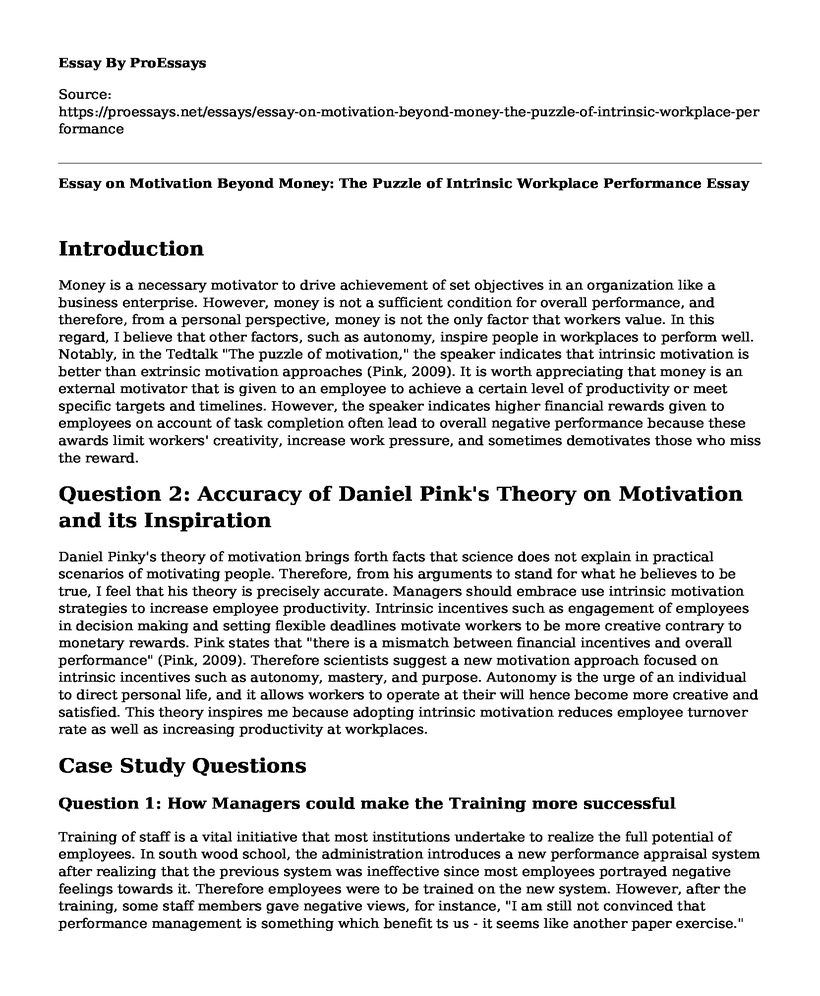Introduction
Money is a necessary motivator to drive achievement of set objectives in an organization like a business enterprise. However, money is not a sufficient condition for overall performance, and therefore, from a personal perspective, money is not the only factor that workers value. In this regard, I believe that other factors, such as autonomy, inspire people in workplaces to perform well. Notably, in the Tedtalk "The puzzle of motivation," the speaker indicates that intrinsic motivation is better than extrinsic motivation approaches (Pink, 2009). It is worth appreciating that money is an external motivator that is given to an employee to achieve a certain level of productivity or meet specific targets and timelines. However, the speaker indicates higher financial rewards given to employees on account of task completion often lead to overall negative performance because these awards limit workers' creativity, increase work pressure, and sometimes demotivates those who miss the reward.
Question 2: Accuracy of Daniel Pink's Theory on Motivation and its Inspiration
Daniel Pinky's theory of motivation brings forth facts that science does not explain in practical scenarios of motivating people. Therefore, from his arguments to stand for what he believes to be true, I feel that his theory is precisely accurate. Managers should embrace use intrinsic motivation strategies to increase employee productivity. Intrinsic incentives such as engagement of employees in decision making and setting flexible deadlines motivate workers to be more creative contrary to monetary rewards. Pink states that "there is a mismatch between financial incentives and overall performance" (Pink, 2009). Therefore scientists suggest a new motivation approach focused on intrinsic incentives such as autonomy, mastery, and purpose. Autonomy is the urge of an individual to direct personal life, and it allows workers to operate at their will hence become more creative and satisfied. This theory inspires me because adopting intrinsic motivation reduces employee turnover rate as well as increasing productivity at workplaces.
Case Study Questions
Question 1: How Managers could make the Training more successful
Training of staff is a vital initiative that most institutions undertake to realize the full potential of employees. In south wood school, the administration introduces a new performance appraisal system after realizing that the previous system was ineffective since most employees portrayed negative feelings towards it. Therefore employees were to be trained on the new system. However, after the training, some staff members gave negative views, for instance, "I am still not convinced that performance management is something which benefit ts us - it seems like another paper exercise." (Robson, 2009, p.5).Such feedback indicates that the training programs failed to meet all set goals. Fortunately, managers could adopt various ways to make the training successful.Allocating adequate time for training could solve the problem, for instance, using four hours per day instead of two hours of sessions. This approach could allow managers to fully exhaust the whole program without a rush and be able to answer questions from the trainees and ultimately satisfy them.
Question 2: Knowledge from the Case and incorporation of Performance Management in my Future Work
The case of training programs on performance appraisals accompanies new elements of planning, designing, and delivery of training programs that I did not know. For example, after assessing the various options, the school management decided to settle on the school Human resource manager to design the training programs (Robson, 2009, p.2). This decision implies that utilizing individuals who are part of a system to handle internal training is better than using external consultants. Such approaches ensure the effective designing of training programs since the person knows internal issues better. At the same time, it eliminates the cost of direct payment to external trainers hence economical. Additionally, the training on a new system or introducing new ideas requires adequate time to achieve set goals. Applying the knowledge on performance appraisal systems training in future work requires one to ensure the implementation of new systems only occurs after thorough training and evaluation of trainees' feedback.
References
Pink, D. (2009, August 26). The Puzzle of Motivation | Dan Pink [Video]. YouTube. https://www.youtube.com/watch?v=rrkrvAUbU9Y
Robson, F. L. (2009). Southwood school: A case study in Training and Development. Society for Human Resource Management (SHRM)
Cite this page
Essay on Motivation Beyond Money: The Puzzle of Intrinsic Workplace Performance. (2023, May 23). Retrieved from https://proessays.net/essays/essay-on-motivation-beyond-money-the-puzzle-of-intrinsic-workplace-performance
If you are the original author of this essay and no longer wish to have it published on the ProEssays website, please click below to request its removal:
- Paper Example on Employee Productivity and Satisfaction: Motivational Ideas and Theories
- Symbolic Analysis of Internship Workplace
- Hospitality Services Management Admission Essay
- Paper Example on GM Strike: UAW Seeks Better Pay, Improved Working Conditions
- Essay on Jose Mourinho: A Journey From School Manager to Soccer Coach
- Essay on Social Media in the Workplace: How Employers Can Guide its Use
- Law Enforcement Career - Free Paper Sample







